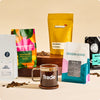If you’re an avid coffee lover (and if you’re here, we’re guessing you are), you probably know coffee comes from a plant. As the seeds of a cherry, coffee beans provide an incredible array of aromas and flavors that can vary based on where the coffee is grown, how it was processed, or how it was brewed. The coffee taste you experience is directly due to decisions and conditions a coffee bean went through before it was poured into your mug.
But let’s go even further back than the brewing method, further back than where a coffee tree is grown, and examine the genetic makeup of a coffee bean. Like other agricultural products — think apples or cabbage or pears—there are several varieties of coffee, or different genetic species under the general umbrella of coffee. All the varieties you’re used to seeing on coffee bags, like bourbon, typica, catimor, etc…all come from two distinct genetic families of coffee: the arabica coffee bean and robusta coffee bean.
We’re breaking down what each of these terms mean.
Arabica vs. Robusta: What’s the Difference?
Let’s travel back to high school biology and look at the coffee plant through different classification terms:
All coffee comes from the Rubiaceae family, a genetically similar group of plants that flower, including the genus Coffea. You can further divide the genus Coffea into distinct species. Arabica coffee beans come from the species Coffea arabica. In contrast, robusta coffee beans come from the Coffea canephora species. There are a few other species of coffee, but they’re nowhere near as popular or plentiful as the arabica bean and the robusta bean.
So, what is Arabica coffee? Coffea arabica is probably what most coffee drinkers are familiar with. Arabica beans make up 75-80% of all coffee production, while robusta makes up the difference at around 20%.1 Arabica beans are more challenging to grow: they’re more delicate, produce about half the amount of cherries, and are much more susceptible to diseases like coffee rust. However, Arabica beans produce the flavors we love in coffee and are often regarded as well-balanced, sweet, and dynamic.
Coffea canephora, on the other hand, is a much heartier plant. Its cherries produce beans with a higher caffeine content than arabica beans, but have been described as having more harsh, woody, and earthy flavors.
A Journey Into Flavor
For a long time, robusta coffee’s reputation as a “harsher” or bitter-tasting bean meant it was relegated to inferior blends. Most robusta beans ended up in places like instant coffees, pre-ground cans, and vacuum-sealed bricks of espresso.
However, the conversations around robusta coffee beans are beginning to shift, especially as climate change illuminates the need to invest in genetically-viable varieties that can withstand environmental challenges. As more and more roasters recognize the need to look at robusta, they’re also beginning to push back on the narrative that robusta is “bad” or that its flavors must be masked or muted.
One of the leaders of this push is Sahra Nguyen, owner of Nguyen Coffee Supply in New York. Vietnam is the second largest producer of coffee in the world and the largest grower of robusta beans, and Nguyen was frustrated by the lack of single origin coffee options from Vietnam. Many restaurants and coffee shops would make Vietnamese-style drinks, but virtually none had coffee from Vietnam. “When an entire coffee variety, robusta bean, is excluded from the specialty coffee community,” their website reads, “it bars robusta farmers all around the world from the opportunity to advance their products and livelihoods.”2
Now, more and more coffee roasters are experimenting with robusta, not just because of the pressing environmental need but because robusta can provide a unique tasting experience. While arabica beans tend to be fruitier, sweeter, and rounder, robusta beans can provide that bold, nutty kick many coffee lovers are looking for.
How To Drink and Brew Arabica and Robusta
Instead of thinking of arabica beans and robusta beans as two opposing forces, when drinking black coffee, many coffee roasters combine the two varieties to create a dynamic coffee blend. Notably, Blue Bottle began including robusta beans in its espresso blends. After opening their location at Mint Plaza in San Francisco in 2008, they set out to “reverse engineer” a typical Italian espresso blend—many of which include robusta beans.3 They came up with 17th Ceiling, a mix that contains a small amount of robusta that provides a deep, pleasantly bitter note that rounds out the entire drinking experience.
Suppose you want to try experimenting with robusta. In that case, there are two good places to start: either try a coffee with robusta as espresso, where the intensity of the brewing method matches the nutty, smoky flavors you might find in a robusta bean; or try a small amount of robusta as a blend component (many of the coffees on Nguyen Coffee Supply’s website are blends of arabica and robusta beans).
Although robusta shines in espresso, you can also try other coffee processing methods that emphasize the body and mouthfeel of the brew, like a French press or cold brew. You can even give the drip coffee method vs pour-over method a try. All these experiences will allow you to learn about the flavor of robusta without getting overwhelmed or over-caffeinated.
You’ll notice that we’re focusing on how to introduce robusta to your coffee drinking experience, and that’s because most specialty coffees come from the arabica plant—even if you’re unaware of what you’re drinking, it’s most likely arabica. For years, robusta has gotten a bad reputation but a handful of roasters are looking to change how we view robusta and find clever ways to incorporate its distinct flavors into delicious coffee blends and brews.
Robusta also represents the future of coffee: although you can find robusta in well-known coffee-growing countries like Brazil and Indonesia, countries like India and China are beginning to grow more and more coffee—much of it robusta. As climate change continues to affect our planet, we must pay attention to new coffee species and regions, and recognize the potential of robusta as a more robust plant.
Arabica and robusta beans provide distinct flavor experiences, and it’s impossible to say if one is better than the other. We encourage you to experiment and try both species of coffee and fiddle with different brewing methods—we’re sure you’ll find a way to express the flavors of both beans beautifully.
Curious about other types of coffee? From Burundi coffee to lungo coffee, Trade has the tips and tricks for you.
Sources






